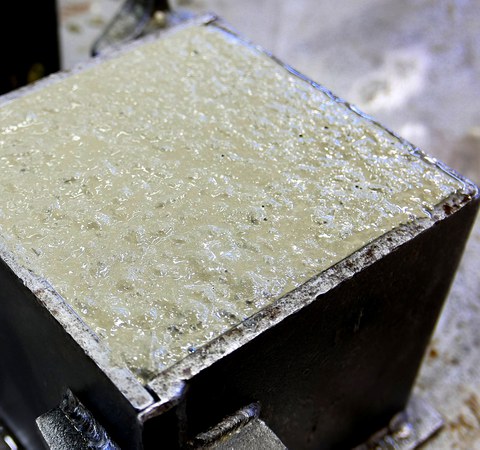Multiple cracking of carbon-reinforced concrete
Table of contents
Project data
|
Titel | Title |
Report from the annual report 2023
Cover joint movements

Fresh air-entrained concrete in a cube formwork
Joints can be found in large and flat structural elements made of concrete and reinforced concrete. For example, they are an integral part of traffic and industrial areas. Pollutants, such as chlorides and sulphates, can be concentrated in component joints. Dissolved in water and transported into the joints, they can slowly destroy the structural elements. The pollutants impair the durability of the structural elements and may lead to contamination of the underlying soil layers as they slowly decompose the concrete. To prevent damage, joint seals are used, whose durability is generally limited to a few years.
But why do these structural elements need joints? Unfortunately, thermally and hygroscopically induced deformations in flat structural elements lead to stress concentrations and cracks if movement and dummy joints do not allow individual areas to expand. Joint-bridging cover layer made of concrete with carbon reinforcement is able to distribute singular joint deformations into a scattered, fine crack pattern and thus to protect flat structural elements from damage.
Such a cover layer absorbs biaxial tensile and compressive loads above the joint intersections. Past tests on textile-reinforced concrete under biaxial tensile loading were always faced with the challenge of a constraint-free load introduction into the test specimen. The internal stress state of the specimens is easily influenced by material concentrations in the load introduction area or the geometric shape of the load introduction. The specimens also frequently failed at the load introduction. In this project, a modification of the load introduction was carried out in order to generate a uniform, biaxial stress state in carbon-reinforced concrete samples as a prerequisite for the investigationof the load bearing and deformation behavior, the crack formation and the bond between carbon reinforcement and concrete under transverse tension.
The air-entrained concrete used requires precise work when mixing, as the admixtures must be precisely adjusted for the desired fresh and solid concrete properties. During the first trials, the consistency was too stiff and the air void content was correspondingly high, or the consistency was too liquid, causing segregation of the fresh concrete. The mixing recipe was improved step by step, resulting in a concrete that was suitable for the road requirements.
Short description
Joints are integral components in planar structural elements made of concrete, e.g., industrial surfaces, parking and traffic areas, retaining walls, etc., in order to avoid unwanted forced cracking. Thermal and hygric-induced inherent deformations are concentrated in movement and dummy joints, into which liquid media including contained pollutants (chlorides, sulfates, alkalis, hydrocarbons, etc.) can penetrate. This impairs the durability of the components and possibly leads to contamination of the underlying soil layers or even washout. To prevent the above-mentioned damage, joint sealants are used that have a durability limited to a few years.
The collaborative project of Ruhr-University Bochum and TU Dresden deals with an alternative solution concept for joint covering. With the aid of thin, textile-reinforced concrete layers, joints in unreinforced or only weakly reinforced concrete components are covered. Carbon-fiber reinforcement, which is characterized by high corrosion resistance and comparatively high tensile strength, is preferred as reinforcement. Due to the large singular joint movements in the base member, a wide single crack would occur in conventional concrete cover layers. The aim is for the fine, high-strength carbon reinforcement to distribute the singular crack pattern to plural, much smaller cracks.
The joint covering made of carbon-reinforced concrete is subject to special stresses in the above-mentioned applications of two-dimensional components. These include tensile stresses that build up in the concrete surface layer during cold seasons as the joints open. Conversely, compressive stresses occur in warm seasons when the joints close. In large concrete surfaces, these stress states occur at joint intersections in two directions. In Dresden, the load-bearing and deformation behavior under uniaxial and biaxial tensile loading is being investigated. Different material combinations are tested. Crack development under tension and transverse tension, the bond behavior of carbon mesh and concrete, and the influence of transverse tension on the course of the bond stress-slip relationship are being investigated. Based on this, we want to develop a model to describe the bond between carbon mesh and concrete under biaxial loading. The collected findings are incorporated into practical regulations so that joint covering can be widely applied in this construction method.
